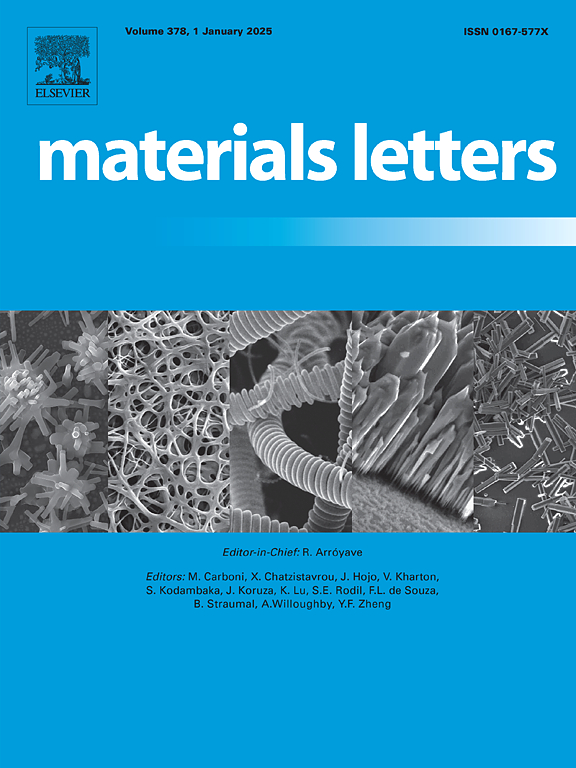基于柔性碳布上掺银 MoO3 纳米棒的高能量密度超级电容器
IF 2.7
4区 材料科学
Q3 MATERIALS SCIENCE, MULTIDISCIPLINARY
引用次数: 0
摘要
本研究采用水热法在柔性纤维碳布上锚定了普通 MoO3 纳米棒和掺杂 Ag 的 MoO3 纳米棒,并通过使用这两种纳米棒制造超级电容器全面评估了它们的性能。在电流密度为 0.5 mA/cm2 时,掺杂基底的比电容比未掺杂的 MoO3 纳米棒高出近四倍。此外,掺银 MoO3 还显示出 43 µWh/cm2 的出色能量密度。掺杂纳米棒的卓越性能归功于它的伪电容行为、更高的电导率以及电极-电解质界面电荷动力学的改善,从而使基于超级电容器的储能系统更高效、更有潜力,以驱动未来的低功耗柔性可穿戴电子设备。本文章由计算机程序翻译,如有差异,请以英文原文为准。
High energy density supercapacitor based on Ag doped MoO3 nanorods on a flexible carbon cloth
In this study, the plain MoO3 and Ag-doped MoO3 nanorods are anchored on a flexible fibrous carbon cloth using a hydrothermal method, and their performances are thoroughly evaluated by fabricating the supercapacitors using both types of nanorods. The doped substrate shows drastic enhancement in specific capacitance which is nearly four times greater than undoped MoO3 nanorods at a current density of 0.5 mA/cm2. Additionally, the Ag doped MoO3 shows an excellent energy density of 43 µWh/cm2. The superior performance of the doped nanorods is attributed to its pseudocapacitive behaviour, higher conductivity, and improved charge kinetics at the electrode–electrolyte interface, enabling a more efficient and potential supercapacitor-based energy storage system to drive future low power flexible and wearable electronic devices.
求助全文
通过发布文献求助,成功后即可免费获取论文全文。
去求助
来源期刊

Materials Letters
工程技术-材料科学:综合
CiteScore
5.60
自引率
3.30%
发文量
1948
审稿时长
50 days
期刊介绍:
Materials Letters has an open access mirror journal Materials Letters: X, sharing the same aims and scope, editorial team, submission system and rigorous peer review.
Materials Letters is dedicated to publishing novel, cutting edge reports of broad interest to the materials community. The journal provides a forum for materials scientists and engineers, physicists, and chemists to rapidly communicate on the most important topics in the field of materials.
Contributions include, but are not limited to, a variety of topics such as:
• Materials - Metals and alloys, amorphous solids, ceramics, composites, polymers, semiconductors
• Applications - Structural, opto-electronic, magnetic, medical, MEMS, sensors, smart
• Characterization - Analytical, microscopy, scanning probes, nanoscopic, optical, electrical, magnetic, acoustic, spectroscopic, diffraction
• Novel Materials - Micro and nanostructures (nanowires, nanotubes, nanoparticles), nanocomposites, thin films, superlattices, quantum dots.
• Processing - Crystal growth, thin film processing, sol-gel processing, mechanical processing, assembly, nanocrystalline processing.
• Properties - Mechanical, magnetic, optical, electrical, ferroelectric, thermal, interfacial, transport, thermodynamic
• Synthesis - Quenching, solid state, solidification, solution synthesis, vapor deposition, high pressure, explosive
 求助内容:
求助内容: 应助结果提醒方式:
应助结果提醒方式:


